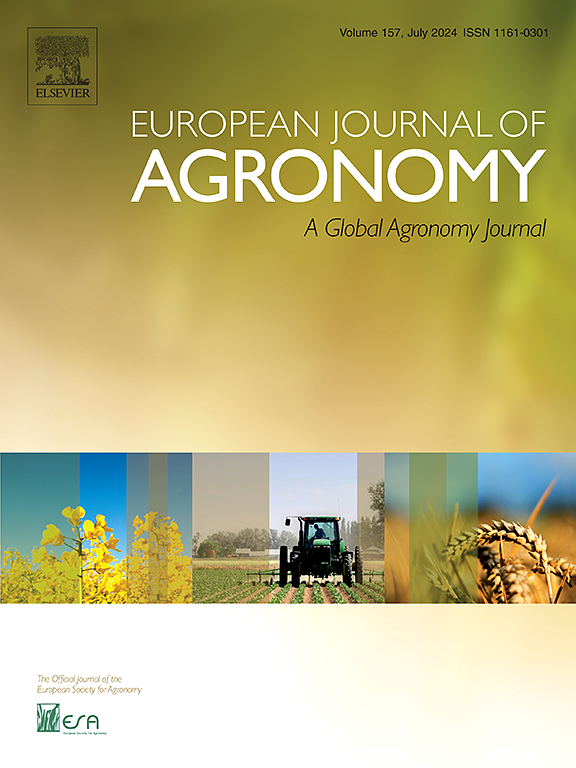华北平原不同种植密度下春玉米产量缺口及其驱动因素
IF 5.5
1区 农林科学
Q1 AGRONOMY
引用次数: 0
摘要
增加种植密度是提高玉米产量的主要农艺措施。随着密度的增加,不同密度间的产量差距(YG)会发生变化。然而,不同植物密度间的YG及其驱动因素却很少受到关注。为此,本研究在华北平原春玉米产区设置了4个试验点,分别为河北泊头(HBT)、山西榆次(YC)、河北南大港(NDG)和内蒙古包头(IBT)。每个试验点的密度分别为6株 × 104、7.5株 × 104和9株 × 104株ha - 1。结合田间管理和气候资料,分析了YG及其驱动因素。结果表明,IBT玉米产量最高,而YG最低,株密度从6 × 104 ~ 7.5 × 104株ha - 1 (YG1)和7.5 × 104 ~ 9 × 104株ha - 1 (YG2)。HBT玉米产量最低,但YG1和YG2产量最高。通过对各驱动因素的相对重要性分析,发现田间管理措施对YG1的影响更大,可独立解释YG1变异的28% %,与产量成分共同解释的贡献率为9% %,与气候条件共同解释的贡献率为6% %。对于YG2, 31 %的变异由产量因素解释,7 %的变异由气候条件共同解释。最后,利用已有的研究数据,对中国不同地区的YG进行了比较和讨论。本研究提出了玉米密实过程中不同密度间的YG。并量化各驱动因素对不同YG的贡献。研究结果可为玉米种植密度策略的制定和玉米耐密度品种的选育提供参考。本文章由计算机程序翻译,如有差异,请以英文原文为准。
Yield gaps and the driving factors under different plant density of spring maize in North China Plain
Increasing planting density is a major agronomic practice to enhance maize yield. With the increasing of plant density, the yield gaps (YG) between different plant densities would be changed. However, YG between different plant densities and the driving factors received little attention. Thus, in this study, a joint field experiment was set at four sites in the spring maize-growing area in North China Plain (NCP), which was at Botou, Hebei province (HBT), Yuci, Shanxi province (YC), Nandagang, Hebei province (NDG), and Baotou, Inner Mongolia (IBT). All the experiments in each sites had three plant densities of 6 × 104, 7.5 × 104, and 9 × 104 plants ha−1. Combining with the field management and climatic data, YG and the driving factors were analyzed. The results showed that the highest maize yield was found at IBT, but with the lowest YG both at plant density changed from 6 × 104 to 7.5 × 104 plants ha−1 (YG1) and 7.5 × 104 to 9 × 104 plants ha−1 (YG2). While the lowest maize yield was found at HBT, but with the highest YG1 and YG2 among the four sites. Through analyzing the relative importance of the driving factors, we found that the field management practices were more important to YG1, which could independently explain 28 % of the variation of YG1, meanwhile with 9 % jointly explanation with yield components, and 6 % jointly explanation with climatic conditions. For the YG2, 31 % variation were explained by the yield components, meanwhile with 7 % jointly explanation with climatic conditions. Finally, we compared and discussed the YG in different areas of China using data from previous studies. The present study proposed the YG between different plant densities during maize densification. And quantify the contribution of the driving factors on different YG. Those results would be meaningful for the formulating of maize planting density strategies, and providing reference to the breeding of maize density-tolerant varieties.
求助全文
通过发布文献求助,成功后即可免费获取论文全文。
去求助
来源期刊

European Journal of Agronomy
农林科学-农艺学
CiteScore
8.30
自引率
7.70%
发文量
187
审稿时长
4.5 months
期刊介绍:
The European Journal of Agronomy, the official journal of the European Society for Agronomy, publishes original research papers reporting experimental and theoretical contributions to field-based agronomy and crop science. The journal will consider research at the field level for agricultural, horticultural and tree crops, that uses comprehensive and explanatory approaches. The EJA covers the following topics:
crop physiology
crop production and management including irrigation, fertilization and soil management
agroclimatology and modelling
plant-soil relationships
crop quality and post-harvest physiology
farming and cropping systems
agroecosystems and the environment
crop-weed interactions and management
organic farming
horticultural crops
papers from the European Society for Agronomy bi-annual meetings
In determining the suitability of submitted articles for publication, particular scrutiny is placed on the degree of novelty and significance of the research and the extent to which it adds to existing knowledge in agronomy.
 求助内容:
求助内容: 应助结果提醒方式:
应助结果提醒方式:


